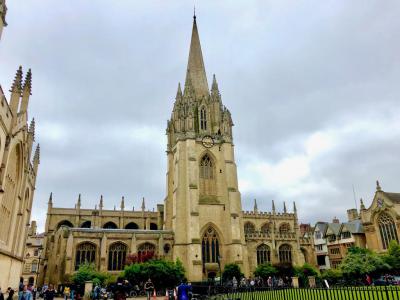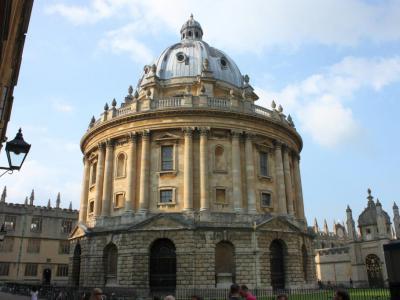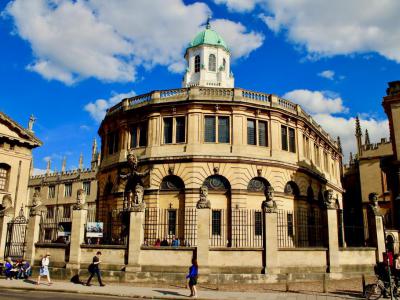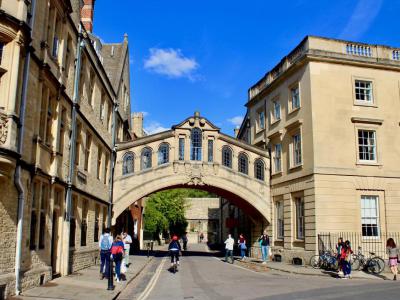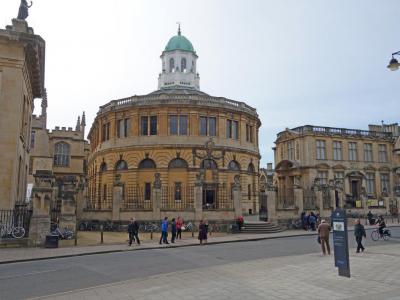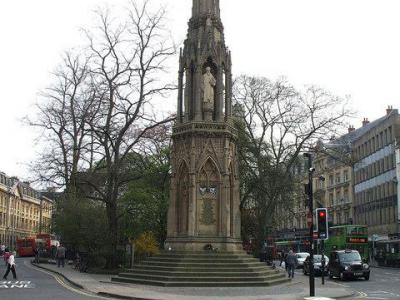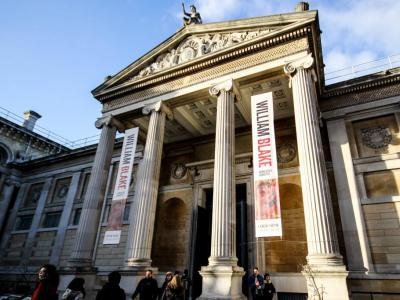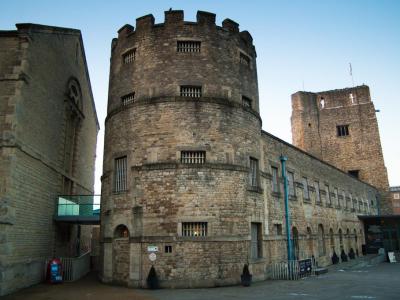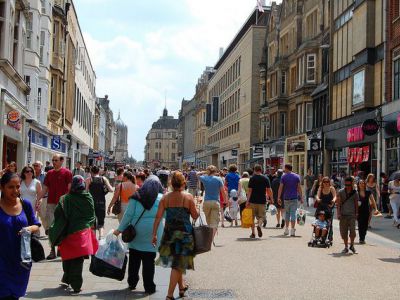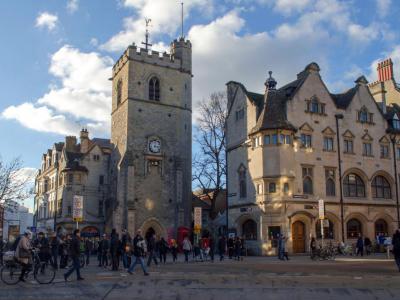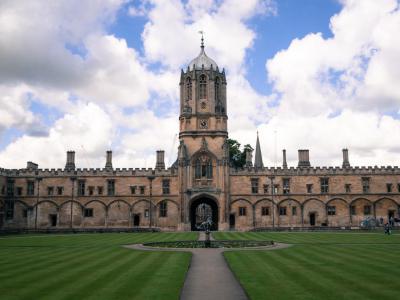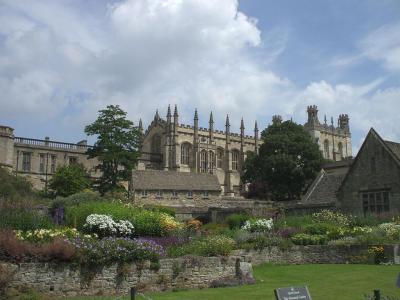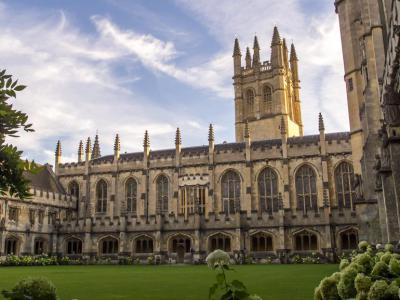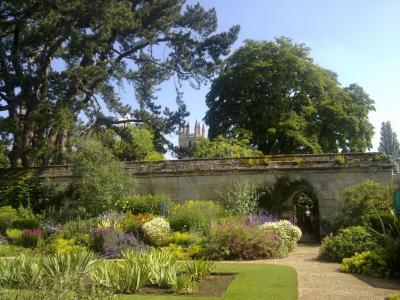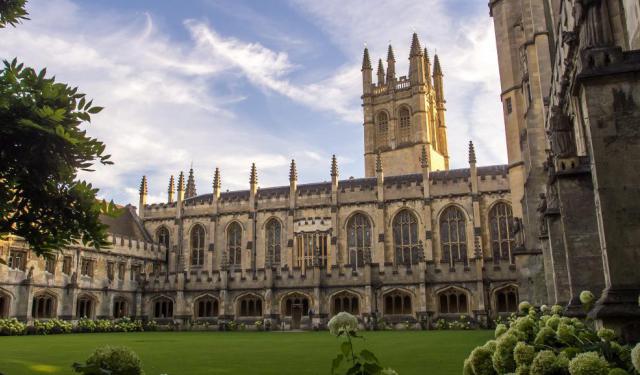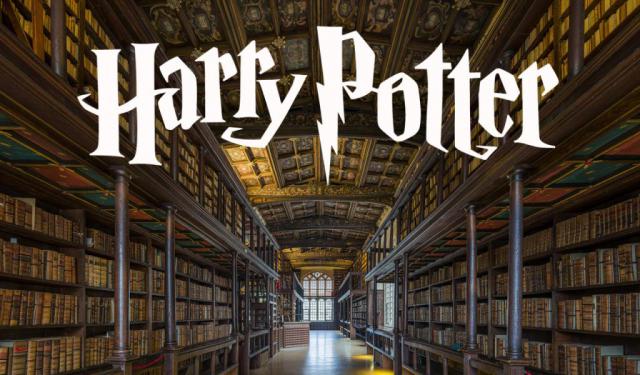
Oxford Introduction Walking Tour (Self Guided), Oxford
Oxford, a city in central England, has captivated the minds of scholars and travelers for centuries. The name "Oxford" originates from the Old English "Oxenaford," which means "shallow crossing of the oxen." It harks back to the early days (circa 900 AD) when a small settlement established by the Anglo-Saxons served as an important crossing point on the upper reaches of the River Thames.
The town grew in importance during the early Norman period. During the English Civil War, it housed the court of Charles I and stood at the heart of national affairs. A heavily ecclesiastical town, Oxford began to grow industrially during the 19th century and had an industrial boom in the early 20th century, which left behind a city developed far beyond the university town of the past.
Indeed, much of Oxford revolves around its prestigious university, established in the late 12th century. The oldest in the English-speaking world, it has been a breeding ground for many eminent thinkers, authors, scientists, and philosophers, making Oxford synonymous with intellectual excellence.
As you explore this charming city, you will encounter a wealth of architectural marvels and cultural treasures. The University Church of Saint Mary the Virgin, with its striking spire, largely contributes to Oxford's nickname, "the City of Dreaming Spires." The Radcliffe Camera, an iconic circular library, and the Bodleian Library, one of the oldest libraries in Europe, house priceless collections of knowledge.
Wander along the picturesque streets, and you'll come across the lovely covered Bridge of Sighs and the Sheldonian Theatre, an exquisite venue for graduations and concerts. The Martyrs' Memorial commemorates the sacrifice of those who gave their lives for religious freedom, while the Ashmolean Museum showcases a vast array of art and artifacts from around the world.
Oxford Castle, with its imposing medieval structure, and the Carfax Tower offer a glimpse into the city's turbulent history, while the bustling Cornmarket Street is perfect for shopping and people-watching. Don't forget to visit Tom Tower and the awe-inspiring Christ Church Cathedral, part of the grand Christ Church College.
The tranquil Magdalen College and the University Of Oxford Botanical Garden, with its lush greenery, provide a serene escape from the city's hustle and bustle.
Intriguing with its storied past and cultural treasures, Oxford beckons you to explore its streets, bask in its intellectual aura, and experience the timeless allure of this historic city. Come and immerse yourself in the legacy of knowledge, art, and architecture that Oxford has to offer, and embark on a journey of discovery like no other.
The town grew in importance during the early Norman period. During the English Civil War, it housed the court of Charles I and stood at the heart of national affairs. A heavily ecclesiastical town, Oxford began to grow industrially during the 19th century and had an industrial boom in the early 20th century, which left behind a city developed far beyond the university town of the past.
Indeed, much of Oxford revolves around its prestigious university, established in the late 12th century. The oldest in the English-speaking world, it has been a breeding ground for many eminent thinkers, authors, scientists, and philosophers, making Oxford synonymous with intellectual excellence.
As you explore this charming city, you will encounter a wealth of architectural marvels and cultural treasures. The University Church of Saint Mary the Virgin, with its striking spire, largely contributes to Oxford's nickname, "the City of Dreaming Spires." The Radcliffe Camera, an iconic circular library, and the Bodleian Library, one of the oldest libraries in Europe, house priceless collections of knowledge.
Wander along the picturesque streets, and you'll come across the lovely covered Bridge of Sighs and the Sheldonian Theatre, an exquisite venue for graduations and concerts. The Martyrs' Memorial commemorates the sacrifice of those who gave their lives for religious freedom, while the Ashmolean Museum showcases a vast array of art and artifacts from around the world.
Oxford Castle, with its imposing medieval structure, and the Carfax Tower offer a glimpse into the city's turbulent history, while the bustling Cornmarket Street is perfect for shopping and people-watching. Don't forget to visit Tom Tower and the awe-inspiring Christ Church Cathedral, part of the grand Christ Church College.
The tranquil Magdalen College and the University Of Oxford Botanical Garden, with its lush greenery, provide a serene escape from the city's hustle and bustle.
Intriguing with its storied past and cultural treasures, Oxford beckons you to explore its streets, bask in its intellectual aura, and experience the timeless allure of this historic city. Come and immerse yourself in the legacy of knowledge, art, and architecture that Oxford has to offer, and embark on a journey of discovery like no other.
How it works: Download the app "GPSmyCity: Walks in 1K+ Cities" from Apple App Store or Google Play Store to your mobile phone or tablet. The app turns your mobile device into a personal tour guide and its built-in GPS navigation functions guide you from one tour stop to next. The app works offline, so no data plan is needed when traveling abroad.
Oxford Introduction Walking Tour Map
Guide Name: Oxford Introduction Walking Tour
Guide Location: England » Oxford (See other walking tours in Oxford)
Guide Type: Self-guided Walking Tour (Sightseeing)
# of Attractions: 14
Tour Duration: 2 Hour(s)
Travel Distance: 3.5 Km or 2.2 Miles
Author: Linda
Sight(s) Featured in This Guide:
Guide Location: England » Oxford (See other walking tours in Oxford)
Guide Type: Self-guided Walking Tour (Sightseeing)
# of Attractions: 14
Tour Duration: 2 Hour(s)
Travel Distance: 3.5 Km or 2.2 Miles
Author: Linda
Sight(s) Featured in This Guide:
- University Church of Saint Mary the Virgin
- Radcliffe Camera
- Bodleian Library
- Bridge of Sighs
- Sheldonian Theatre
- Martyrs' Memorial
- Ashmolean Museum
- Oxford Castle
- Cornmarket Street
- Carfax Tower
- Tom Tower
- Christ Church Cathedral
- Magdalen College
- University Of Oxford Botanical Garden
1) University Church of Saint Mary the Virgin (must see)
The University Church of Saint Mary the Virgin is the largest parish church in Oxford. It stands on High Street and is surrounded by colleges, which is why it is so popular with the students and professors.
The first church on this site was built in 1086 and when the university was founded in the 13th century, it was considered to be its first building. In 1320, a two-storey edifice was constructed on the north side of the chancel; the ground floor was the university’s Convocation House and today it houses Vault Café. The upper floor became the university’s first library, with books donated by Thomas Cobham.
The church’s Baroque porch was designed by Nicholas Stone. Its 13th century tower affords excellent views, and is open to the public. The steeple is reputed to be the most beautiful in England.
In 1555, the Oxford Martyrs were tried and condemned inside this church. You will notice that a section of the pillar opposite the pulpit is missing. This was cut out to support a small platform where the former Archbishop of Canterbury, Thomas Cranmer, stood while withdrawing his recantation of his Protestant faith, before being taken out and burnt at the stake.
At the end of the 15th and the early 16th centuries, most of the church was rebuilt in the Perpendicular style, only the tower and the spire remained untouched. Out of the 12 statues, 11 were replaced in 1894 by George Frampton.
Into the 17th century, the church was used for graduation ceremonies, until the church officials got fed up with the very un-Christian parties held afterwards, and therefore they had the Sheldonian Theatre built to host the ceremonies instead.
The first church on this site was built in 1086 and when the university was founded in the 13th century, it was considered to be its first building. In 1320, a two-storey edifice was constructed on the north side of the chancel; the ground floor was the university’s Convocation House and today it houses Vault Café. The upper floor became the university’s first library, with books donated by Thomas Cobham.
The church’s Baroque porch was designed by Nicholas Stone. Its 13th century tower affords excellent views, and is open to the public. The steeple is reputed to be the most beautiful in England.
In 1555, the Oxford Martyrs were tried and condemned inside this church. You will notice that a section of the pillar opposite the pulpit is missing. This was cut out to support a small platform where the former Archbishop of Canterbury, Thomas Cranmer, stood while withdrawing his recantation of his Protestant faith, before being taken out and burnt at the stake.
At the end of the 15th and the early 16th centuries, most of the church was rebuilt in the Perpendicular style, only the tower and the spire remained untouched. Out of the 12 statues, 11 were replaced in 1894 by George Frampton.
Into the 17th century, the church was used for graduation ceremonies, until the church officials got fed up with the very un-Christian parties held afterwards, and therefore they had the Sheldonian Theatre built to host the ceremonies instead.
2) Radcliffe Camera (must see)
The Radcliffe Camera, despite its name, isn't a camera in the technical sense; rather, it is the first circular library ever constructed in the United Kingdom. In this context, "camera" is synonymous with "chamber."
John Radcliffe, a royal physician, expressed his desire to build a library at the University to house his collection of scientific materials. This led to a debate among several colleges over which of them should have the honor of hosting the library. Ultimately, none of the colleges were chosen.
To make room for the library, several terraced houses on Cattle Street, the Black Hall, and some outbuildings from Brasenose College were demolished. Constructed in 1749 by James Gibbes in the English Palladian architectural style, the exterior of the Radcliffe Camera appears to have three stories. The ground floor is rusticated, while the first floor is divided into sections by ten pairs of Corinthian columns. Above this section is a lantern and a dome covered in lead.
Inside the building, the first floor serves as an open gallery that runs along the walls. There is a 2-meter-high statue of John Radcliffe, sculpted by John Rysbrack. In 1912, an underground archives room was established, connected to the Bodleian Library through a passage.
The Radcliffe Camera houses an impressive collection of over 600,000 books and now functions as a reading room affiliated with the Bodleian Library. Unfortunately, it is not accessible to the general public.
John Radcliffe, a royal physician, expressed his desire to build a library at the University to house his collection of scientific materials. This led to a debate among several colleges over which of them should have the honor of hosting the library. Ultimately, none of the colleges were chosen.
To make room for the library, several terraced houses on Cattle Street, the Black Hall, and some outbuildings from Brasenose College were demolished. Constructed in 1749 by James Gibbes in the English Palladian architectural style, the exterior of the Radcliffe Camera appears to have three stories. The ground floor is rusticated, while the first floor is divided into sections by ten pairs of Corinthian columns. Above this section is a lantern and a dome covered in lead.
Inside the building, the first floor serves as an open gallery that runs along the walls. There is a 2-meter-high statue of John Radcliffe, sculpted by John Rysbrack. In 1912, an underground archives room was established, connected to the Bodleian Library through a passage.
The Radcliffe Camera houses an impressive collection of over 600,000 books and now functions as a reading room affiliated with the Bodleian Library. Unfortunately, it is not accessible to the general public.
3) Bodleian Library (must see)
Bodleian Library is the main research library of Oxford University, and if you are not a student, you can visit it on a guided tour which should be booked in advance.
The Bodleian is one of the oldest reference libraries in Europe and one of the six legal deposit libraries in the United Kingdom, which means that a copy of every book published in the UK and Ireland is required by law to be deposited here.
The 1st library was founded by Thomas Cobham, the Bishop of Worcester, in the 14th century. It was a chained library – the books were chained to the shelves to stop people pinching them. In 1437, after the Duke of Gloucester donated a vast number of manuscripts, the building proved too small, so Duke Humphrey’s Library was built at Divinity School.
Over the years, the library fell into disuse until 1598 when a Fellow of Merton College, Thomas Bodley, had the place renovated and enlarged to receive his collection of books. It reopened in 1602 and took its present-day name. It was also Bodley who made an agreement with the Stationer’s Company in 1610 to put a copy of each of their books in the library. This agreement became the Deposit Law in the 19th century.
The library expanded in 1612 and 1637 and grew popular with Fellows to donate or bequeath their collections. The New Library was built in 1937 and today a tunnel under Broad Street connects the Old and the New Bodleian.
The library holds a staggering 11 million books and other reading matter, 117 miles of shelves and 400 staff members. Among the ancient manuscripts here is a copy of the Magna Charta and the Song of Roland. It also houses one of the last copies of the Guttenberg Bible.
***Harry Potter Tour***
Hidden away in the Bodleian Library, the Duke Humfrey’s reading room revels in a magical atmosphere. Boasting imposing high walls and an intricately painted ceiling, even the smallest of Harry Potter fans will fail to ignore this eye-catching beauty. Presented as the main Hogwarts Library in the film series, it is most memorable for the scene in The Philosopher’s Stone, when Harry uses his Cloak of Invisibility to sneak into the restricted section of the library. We see Harry creeping around here before he is given away by a screaming book.
The Bodleian is one of the oldest reference libraries in Europe and one of the six legal deposit libraries in the United Kingdom, which means that a copy of every book published in the UK and Ireland is required by law to be deposited here.
The 1st library was founded by Thomas Cobham, the Bishop of Worcester, in the 14th century. It was a chained library – the books were chained to the shelves to stop people pinching them. In 1437, after the Duke of Gloucester donated a vast number of manuscripts, the building proved too small, so Duke Humphrey’s Library was built at Divinity School.
Over the years, the library fell into disuse until 1598 when a Fellow of Merton College, Thomas Bodley, had the place renovated and enlarged to receive his collection of books. It reopened in 1602 and took its present-day name. It was also Bodley who made an agreement with the Stationer’s Company in 1610 to put a copy of each of their books in the library. This agreement became the Deposit Law in the 19th century.
The library expanded in 1612 and 1637 and grew popular with Fellows to donate or bequeath their collections. The New Library was built in 1937 and today a tunnel under Broad Street connects the Old and the New Bodleian.
The library holds a staggering 11 million books and other reading matter, 117 miles of shelves and 400 staff members. Among the ancient manuscripts here is a copy of the Magna Charta and the Song of Roland. It also houses one of the last copies of the Guttenberg Bible.
***Harry Potter Tour***
Hidden away in the Bodleian Library, the Duke Humfrey’s reading room revels in a magical atmosphere. Boasting imposing high walls and an intricately painted ceiling, even the smallest of Harry Potter fans will fail to ignore this eye-catching beauty. Presented as the main Hogwarts Library in the film series, it is most memorable for the scene in The Philosopher’s Stone, when Harry uses his Cloak of Invisibility to sneak into the restricted section of the library. We see Harry creeping around here before he is given away by a screaming book.
4) Bridge of Sighs (must see)
Unfortunately, if you are not a student of Hertford College, you won’t be able to cross the Bridge of Sighs, but you can certainly admire it from street level and add a photo of it to your collection of Oxford’s marvellous structures.
The real name of the bridge is the Hertford Bridge and it was built in 1914 by Sir Thomas Jackson. It took its popular name from the fact that it is supposed to look just like the bridge of the same name in Venice. Actually, it resembles the Rialto Bridge more than anything else, but the Bridge of Sighs sounds more romantic.
The bridge is a fine example of the Quadrature of the Parabola, developed by Archimedes in the 3rd century BC – a rather difficult geometrical concept in that the area of a parabolic segment is 4/3 of a certain inscribed triangle. It all comes down to the triangle (top) of the bridge being supported by the arch (parabola) because they are of the same base length and height.
Leaving the Maths lesson behind, the bridge is covered and glass panelled and links the college’s Old Quad with the New Quad. According to popular legend, the college once closed the bridge to overweight students, forcing them to get some exercise by taking the long route from one building to another.
***Harry Potter Walk***
Conveniently easy to spot behind Oxford’s very own Bridge of Sighs, the ancient (almost 200-year-old) giant Oak Tree, featured during a duel between Harry Potter and Draco Malfoy in Harry Potter and the Goblet of Fire, can be seen in New College Cloisters. And while the cloisters themselves are closed to the public, a photo of the tree can still be snapped from the roadside!
The real name of the bridge is the Hertford Bridge and it was built in 1914 by Sir Thomas Jackson. It took its popular name from the fact that it is supposed to look just like the bridge of the same name in Venice. Actually, it resembles the Rialto Bridge more than anything else, but the Bridge of Sighs sounds more romantic.
The bridge is a fine example of the Quadrature of the Parabola, developed by Archimedes in the 3rd century BC – a rather difficult geometrical concept in that the area of a parabolic segment is 4/3 of a certain inscribed triangle. It all comes down to the triangle (top) of the bridge being supported by the arch (parabola) because they are of the same base length and height.
Leaving the Maths lesson behind, the bridge is covered and glass panelled and links the college’s Old Quad with the New Quad. According to popular legend, the college once closed the bridge to overweight students, forcing them to get some exercise by taking the long route from one building to another.
***Harry Potter Walk***
Conveniently easy to spot behind Oxford’s very own Bridge of Sighs, the ancient (almost 200-year-old) giant Oak Tree, featured during a duel between Harry Potter and Draco Malfoy in Harry Potter and the Goblet of Fire, can be seen in New College Cloisters. And while the cloisters themselves are closed to the public, a photo of the tree can still be snapped from the roadside!
5) Sheldonian Theatre (must see)
While Oxford University was initially established by clergy members with a primary focus on theology education, it quickly evolved to serve various purposes beyond academic study. One such multifunctional building is the Sheldonian Theatre.
For numerous centuries, graduation ceremonies were conducted at Saint Mary the Virgin on High Church. These events often transformed into lively celebrations, a stark contrast to the solemn religious setting. This displeased the church's clergy to the extent that in 1660, they sought assistance from Gilbert Sheldon, who served as the University's Chancellor. Sheldon, who later became the Archbishop of Canterbury, not only embraced the idea but also personally financed the construction of a dedicated venue for these ceremonies.
The theater's design was entrusted to Sir Christopher Wren, who departed from the prevalent Gothic architectural style. Instead, he drew inspiration from the 1st-century BC Theatre of Marcellus in Rome. However, a challenge arose due to the D-shaped structure being too wide for the roof beams to support. To overcome this issue, Wren employed a geometric grid pattern, originally devised by John Wallis in 1648. This pattern featured a lattice framework of timber trusses and crossbeams, eliminating the need for additional supporting pillars. In 1802, George Saunders oversaw the reconstruction of the roof.
Adorning the ceiling are 32 oil-on-canvas panels, forming a captivating fresco that narrates the story of Truth, Arts, and Sciences triumphing over Ignorance within the University. Today, in addition to graduation ceremonies, the theater serves as a venue for various events such as conferences, lectures, and music recitals.
A remarkable feature of the theater is its octagonal lantern situated at the center of the roof, with windows on all sides. This offers splendid panoramic views of the city and is accessible to the general public.
For numerous centuries, graduation ceremonies were conducted at Saint Mary the Virgin on High Church. These events often transformed into lively celebrations, a stark contrast to the solemn religious setting. This displeased the church's clergy to the extent that in 1660, they sought assistance from Gilbert Sheldon, who served as the University's Chancellor. Sheldon, who later became the Archbishop of Canterbury, not only embraced the idea but also personally financed the construction of a dedicated venue for these ceremonies.
The theater's design was entrusted to Sir Christopher Wren, who departed from the prevalent Gothic architectural style. Instead, he drew inspiration from the 1st-century BC Theatre of Marcellus in Rome. However, a challenge arose due to the D-shaped structure being too wide for the roof beams to support. To overcome this issue, Wren employed a geometric grid pattern, originally devised by John Wallis in 1648. This pattern featured a lattice framework of timber trusses and crossbeams, eliminating the need for additional supporting pillars. In 1802, George Saunders oversaw the reconstruction of the roof.
Adorning the ceiling are 32 oil-on-canvas panels, forming a captivating fresco that narrates the story of Truth, Arts, and Sciences triumphing over Ignorance within the University. Today, in addition to graduation ceremonies, the theater serves as a venue for various events such as conferences, lectures, and music recitals.
A remarkable feature of the theater is its octagonal lantern situated at the center of the roof, with windows on all sides. This offers splendid panoramic views of the city and is accessible to the general public.
6) Martyrs' Memorial
Since the dawn of time, man has committed atrocities in the name of religion. The Martyrs Memorial on the intersection of Beaumont Street, Magdalen Street and Saint Giles’, is a mute testament to one of those acts.
In 1553, Queen Mary Tudor succeeded her brother Edward VI to the English Crown and restored Roman Catholicism as the main religion. In 1555, she accused The Archbishop of Canterbury, Thomas Cranmer, and two other Anglican Bishops, Nicholas Rigby and Hugh Latimer, of heresy.
It was known that she hated Cranmer, who had dissolved the marriage of her father, Henry VIII, and her mother, Catherine of Aragon, thus making Mary an illegitimate child. The three men were tried and burnt at the stake, Rigby and Latimer in 1555 and Cranmer in 1566.
The Martyrs Memorial is a lovely Victorian Gothic structure that looks very much like a cathedral spire. The three statues of the martyrs were sculpted by Henry Weeks. Sometimes students tell foreign visitors that the memorial is the spire of an underground church and direct them to a flight of steps that lead, in reality, to the public lavatories.
The memorial was designed by Sir George Scott in 1843 and bears a very anti-Catholic inscription. It served as a reminder to the members of the Oxford movement of the very high price the martyrs paid for their religious beliefs.
In 1553, Queen Mary Tudor succeeded her brother Edward VI to the English Crown and restored Roman Catholicism as the main religion. In 1555, she accused The Archbishop of Canterbury, Thomas Cranmer, and two other Anglican Bishops, Nicholas Rigby and Hugh Latimer, of heresy.
It was known that she hated Cranmer, who had dissolved the marriage of her father, Henry VIII, and her mother, Catherine of Aragon, thus making Mary an illegitimate child. The three men were tried and burnt at the stake, Rigby and Latimer in 1555 and Cranmer in 1566.
The Martyrs Memorial is a lovely Victorian Gothic structure that looks very much like a cathedral spire. The three statues of the martyrs were sculpted by Henry Weeks. Sometimes students tell foreign visitors that the memorial is the spire of an underground church and direct them to a flight of steps that lead, in reality, to the public lavatories.
The memorial was designed by Sir George Scott in 1843 and bears a very anti-Catholic inscription. It served as a reminder to the members of the Oxford movement of the very high price the martyrs paid for their religious beliefs.
7) Ashmolean Museum (must see)
The Ashmolean Museum, located on Beaumont Street, is a captivating museum that can be likened to a treasure trove, offering a delightful experience for all.
Established in 1678 with the purpose of housing the cabinet of curiosities donated by Elias Ashmole, this museum holds the distinction of being the world's first university museum. In 1845, it relocated to its current premises, which were designed by Charles Cockerall to accommodate its ever-expanding collection.
Within the museum, you will find an impressive array of Pre-Raphaelite paintings, along with drawings by renowned artists such as da Vinci, Michelangelo, and Raphael. Additionally, there are several watercolor works by Turner on display.
Many of the archaeological artifacts showcased here come from the personal collections of Elias Ashmole, as well as those of John Tradescant the Elder and the Younger. These individuals were not only collectors but also naturalists, botanists, and travelers.
The exhibitions encompass a diverse range of items, including ancient coins, books, engravings, and geological specimens. Notably, the museum boasts a beautiful assortment of Greek and Minoan pottery, as well as artifacts from Ancient Egypt and Sudan, which were originally part of Arthur Evans' estate. Arthur Evans was the archaeologist renowned for excavating the Palace of Knossos on the island of Crete.
Furthermore, the museum's collection features a captivating mix of curiosities. Among them are Oliver Cromwell's Death Mask, the lantern used by Guy Fawkes in his infamous attempt to blow up the Houses of Parliament, the Alfred Jewel, the Abingdon Sword, and Lawrence of Arabia's ceremonial Arab head-dress.
Established in 1678 with the purpose of housing the cabinet of curiosities donated by Elias Ashmole, this museum holds the distinction of being the world's first university museum. In 1845, it relocated to its current premises, which were designed by Charles Cockerall to accommodate its ever-expanding collection.
Within the museum, you will find an impressive array of Pre-Raphaelite paintings, along with drawings by renowned artists such as da Vinci, Michelangelo, and Raphael. Additionally, there are several watercolor works by Turner on display.
Many of the archaeological artifacts showcased here come from the personal collections of Elias Ashmole, as well as those of John Tradescant the Elder and the Younger. These individuals were not only collectors but also naturalists, botanists, and travelers.
The exhibitions encompass a diverse range of items, including ancient coins, books, engravings, and geological specimens. Notably, the museum boasts a beautiful assortment of Greek and Minoan pottery, as well as artifacts from Ancient Egypt and Sudan, which were originally part of Arthur Evans' estate. Arthur Evans was the archaeologist renowned for excavating the Palace of Knossos on the island of Crete.
Furthermore, the museum's collection features a captivating mix of curiosities. Among them are Oliver Cromwell's Death Mask, the lantern used by Guy Fawkes in his infamous attempt to blow up the Houses of Parliament, the Alfred Jewel, the Abingdon Sword, and Lawrence of Arabia's ceremonial Arab head-dress.
8) Oxford Castle (must see)
Oxford takes great pride in its rich history and dedicates significant resources to maintaining its ancient structures, as evidenced by the preservation efforts at Oxford Castle. This partially ruined Norman castle stands on the western outskirts of the town, just off New Road. Initially, it consisted of a wooden motte and bailey castle, which was later replaced by stone buildings in the 11th century.
During the conflict between England and Normandy from 1135 to 1153, the castle served as a strategic base for Empress Matilda, the daughter of King Henry I, in her quest to claim the English throne from her cousin, King Stephen. King Stephen besieged the castle with siege engines, but Matilda managed to escape, leading to the surrender of the castle's occupants before a full-scale battle could commence.
In the 13th century, further fortifications were added, including the construction of the Round Tower and the restoration of the chapel. King Henry III utilized the castle as a prison. However, during the English Civil War, the castle suffered significant damage and continued to function as a prison after the war's conclusion.
In 1888, the prison underwent expansion and operated as HM Prison Oxford until its closure in 1996. Today, only the motte and Saint George's Tower remain as remnants of the original castle.
The former prison buildings have been repurposed into a luxury hotel, office spaces, a shopping center, and a heritage complex. The castle's courtyard now hosts an open market and frequently features theater performances.
Additionally, Oxford Castle offers guided tours led by guides dressed in period costumes, providing insights into the castle's history. Visitors can explore Saint George's Tower, visit the crypt, and access the motte with its vaulted Well Chamber as part of the tour experience.
During the conflict between England and Normandy from 1135 to 1153, the castle served as a strategic base for Empress Matilda, the daughter of King Henry I, in her quest to claim the English throne from her cousin, King Stephen. King Stephen besieged the castle with siege engines, but Matilda managed to escape, leading to the surrender of the castle's occupants before a full-scale battle could commence.
In the 13th century, further fortifications were added, including the construction of the Round Tower and the restoration of the chapel. King Henry III utilized the castle as a prison. However, during the English Civil War, the castle suffered significant damage and continued to function as a prison after the war's conclusion.
In 1888, the prison underwent expansion and operated as HM Prison Oxford until its closure in 1996. Today, only the motte and Saint George's Tower remain as remnants of the original castle.
The former prison buildings have been repurposed into a luxury hotel, office spaces, a shopping center, and a heritage complex. The castle's courtyard now hosts an open market and frequently features theater performances.
Additionally, Oxford Castle offers guided tours led by guides dressed in period costumes, providing insights into the castle's history. Visitors can explore Saint George's Tower, visit the crypt, and access the motte with its vaulted Well Chamber as part of the tour experience.
9) Cornmarket Street
Cornmarket Street, commonly referred to as Cornmarket or simply The Corn, is a significant pedestrian pathway in Oxford. It stretches between Carfax Tower in the northern direction and Magdalen Street in the southern direction. In the year 1999, the street underwent a transformation and became a pedestrian-only zone.
To the east of Cornmarket Street, you'll find the charming Golden Cross arcade. This arcade houses a collection of small jewelry and craft shops within a historical courtyard, leading visitors to the Covered Market. On the western side of the street, there's the Clarendon Shopping Centre, an indoor shopping complex that extends in an L-shape and connects to Queen Street.
One notable historical structure on Cornmarket is the building located at 26–28 Cornmarket. This timber-framed building dates back to the 14th century and is a remnant of the New Inn, which was completed in 1386. This building is now owned by Jesus College and underwent an investigative and restorative process in 1983.
One of the most prominent retail establishments on Cornmarket Street is the largest department store in Oxford, situated at number 50. Boswells of Oxford founded this store in 1738. In 1928, the store introduced a new main entrance on Broad Street, while still maintaining an entrance on Cornmarket.
The tower of the Church of England parish church of Saint Michael at the Northgate holds the distinction of being the oldest structure in Oxford. It originates from the Saxon era and can be traced back to around the years 1000–1050. The church derives its name from the medieval gate that once existed at the northern terminus of Cornmarket, known as Oxford's city walls.
To the east of Cornmarket Street, you'll find the charming Golden Cross arcade. This arcade houses a collection of small jewelry and craft shops within a historical courtyard, leading visitors to the Covered Market. On the western side of the street, there's the Clarendon Shopping Centre, an indoor shopping complex that extends in an L-shape and connects to Queen Street.
One notable historical structure on Cornmarket is the building located at 26–28 Cornmarket. This timber-framed building dates back to the 14th century and is a remnant of the New Inn, which was completed in 1386. This building is now owned by Jesus College and underwent an investigative and restorative process in 1983.
One of the most prominent retail establishments on Cornmarket Street is the largest department store in Oxford, situated at number 50. Boswells of Oxford founded this store in 1738. In 1928, the store introduced a new main entrance on Broad Street, while still maintaining an entrance on Cornmarket.
The tower of the Church of England parish church of Saint Michael at the Northgate holds the distinction of being the oldest structure in Oxford. It originates from the Saxon era and can be traced back to around the years 1000–1050. The church derives its name from the medieval gate that once existed at the northern terminus of Cornmarket, known as Oxford's city walls.
10) Carfax Tower (must see)
Carfax Tower stands at the junction of four streets – Cornmarket Street to the north, Saint Aldate’s to the south, High Street to the east, and Queen Street to the west – which is probably the exact geographical centre of Oxford.
The tower stands on the north-east corner of the junction and is the only remnant of the 13th century Saint Martin’s Church. From 1122 to 1896, this had been the City Church of Oxford until it was partially demolished to make way for a new road. Further road widening led to the rest of the church being pulled down in 1900.
The tower stands 23 metres high and no other building in the city is allowed to be higher. It has a ring of six bells that were cast in 1676 by Richard Keene. They still ring out the quarter hour, but the two quarter boys that used to strike them are no longer in use. The bells are rung on special occasions by the Oxford Society of Change Ringers.
Behind the tower you will see a solitary tombstone. It is that of William Butler, who was once the mayor of Oxford. He was buried here in 1865, but when the church was demolished, the tombstone was forgotten and, together with the tower, it is now classed as a Grade II listed building.
The tower stands on the north-east corner of the junction and is the only remnant of the 13th century Saint Martin’s Church. From 1122 to 1896, this had been the City Church of Oxford until it was partially demolished to make way for a new road. Further road widening led to the rest of the church being pulled down in 1900.
The tower stands 23 metres high and no other building in the city is allowed to be higher. It has a ring of six bells that were cast in 1676 by Richard Keene. They still ring out the quarter hour, but the two quarter boys that used to strike them are no longer in use. The bells are rung on special occasions by the Oxford Society of Change Ringers.
Behind the tower you will see a solitary tombstone. It is that of William Butler, who was once the mayor of Oxford. He was buried here in 1865, but when the church was demolished, the tombstone was forgotten and, together with the tower, it is now classed as a Grade II listed building.
11) Tom Tower
On your first evening in Oxford you may will be surprised to hear a bell ringing out 101 times at five past nine. Something is strange here and the next morning you will seek out the source of this oddity, which is to be found in Tom Tower over Tom Gate, on Saint Aldates, the main entrance of Christ Church. It leads into The Great Quadrangle, more popularly known as Tom Quad - one of the quadrangles of Christ Church and the largest college quad in Oxford.
The bell tower was designed by Cardinal Wolsey in 1532, but when the Cardinal fell from power, the building remained unfinished. A 150 years later, Sir Christopher Wren was commissioned to finish the tower and his designs kept to the original late Gothic style, even though it had been out of fashion for a long time.
The work was carried out by master stonemason, Christopher Kempster. The tower is square with an octagonal lantern topped by an ogee dome, which has been copied many times over the centuries.
The bell inside the tower is called Great Tom. It weighs over 7 tons and is 1.52 metres high and 2.13 metres across the base. It is unclear exactly when the bell was first cast, but early records name it Mary and until 1545 it hung in Osrey Abbey, upon which it was moved to Saint Fridewide’s Church and renamed Tom.
It had been recast three times before it was moved to Tom Tower in 1682. The final recasting before its installation was carried out by Christopher Hodson.
As to the hour it chimes its 101 peal: Oxford time was once calculated five minutes after Greenwich Time. This isn’t unusual, as most towns had their own time until 1848, when Railway Time was officially adopted, based on Greenwich Time. The 101 peals were once a signal for the college’s original 101 students to return before the gates closed. It remains to this day a part of college tradition.
The bell tower was designed by Cardinal Wolsey in 1532, but when the Cardinal fell from power, the building remained unfinished. A 150 years later, Sir Christopher Wren was commissioned to finish the tower and his designs kept to the original late Gothic style, even though it had been out of fashion for a long time.
The work was carried out by master stonemason, Christopher Kempster. The tower is square with an octagonal lantern topped by an ogee dome, which has been copied many times over the centuries.
The bell inside the tower is called Great Tom. It weighs over 7 tons and is 1.52 metres high and 2.13 metres across the base. It is unclear exactly when the bell was first cast, but early records name it Mary and until 1545 it hung in Osrey Abbey, upon which it was moved to Saint Fridewide’s Church and renamed Tom.
It had been recast three times before it was moved to Tom Tower in 1682. The final recasting before its installation was carried out by Christopher Hodson.
As to the hour it chimes its 101 peal: Oxford time was once calculated five minutes after Greenwich Time. This isn’t unusual, as most towns had their own time until 1848, when Railway Time was officially adopted, based on Greenwich Time. The 101 peals were once a signal for the college’s original 101 students to return before the gates closed. It remains to this day a part of college tradition.
12) Christ Church Cathedral (must see)
Christ Church Cathedral holds a unique position as both a college chapel and the cathedral of the Diocese of Oxford. Prior to the 20th century, it was also the smallest cathedral in the United Kingdom.
Its historical roots trace back to before the Norman Conquest when a shrine was constructed on the site in memory of Saint Frideswide, a 7th-century priestess who faced persecution and sought to protect her chastity from King Algar, one of the rulers of the Seven Kingdoms of Saxony.
By 1122, the cathedral became a part of Saint Frideswide Priory. However, in 1520, Cardinal Wolsey seized the buildings and lands to establish Cardinal College. To make room for what is now Tom Quad, five bays in the western part of the nave were demolished. Eventually, King Henry VIII took over and had Christ Church College constructed upon the foundation.
The remainder of the cathedral was built in the Perpendicular or English Gothic style. The eastern part of the nave, the choir, and the tower retained the original Norman appearance.
Notable features include the exquisite rose window in the Botanical style with ten petals around the central glass. Other noteworthy windows are the Becket Window from 1320, which survived the Reformation, and the Jonah Window, depicting the City of Nineveh, created in 1632.
The shrine of Saint Frideswide has been restored and stands before a stunning stained glass window with 16 panels recounting her life. An interesting detail is the 16th panel, which includes a water-closet, a clear indication of its Victorian origin, certainly not present in the 8th century.
The Cathedral Shop, where visitors can purchase souvenirs, books, CDs, and other gift items, is located in the 12th-century Chapter House. While perusing the shelves, be sure to admire the vaulted ceiling adorned with 13th-century medallions depicting the Saints.
Its historical roots trace back to before the Norman Conquest when a shrine was constructed on the site in memory of Saint Frideswide, a 7th-century priestess who faced persecution and sought to protect her chastity from King Algar, one of the rulers of the Seven Kingdoms of Saxony.
By 1122, the cathedral became a part of Saint Frideswide Priory. However, in 1520, Cardinal Wolsey seized the buildings and lands to establish Cardinal College. To make room for what is now Tom Quad, five bays in the western part of the nave were demolished. Eventually, King Henry VIII took over and had Christ Church College constructed upon the foundation.
The remainder of the cathedral was built in the Perpendicular or English Gothic style. The eastern part of the nave, the choir, and the tower retained the original Norman appearance.
Notable features include the exquisite rose window in the Botanical style with ten petals around the central glass. Other noteworthy windows are the Becket Window from 1320, which survived the Reformation, and the Jonah Window, depicting the City of Nineveh, created in 1632.
The shrine of Saint Frideswide has been restored and stands before a stunning stained glass window with 16 panels recounting her life. An interesting detail is the 16th panel, which includes a water-closet, a clear indication of its Victorian origin, certainly not present in the 8th century.
The Cathedral Shop, where visitors can purchase souvenirs, books, CDs, and other gift items, is located in the 12th-century Chapter House. While perusing the shelves, be sure to admire the vaulted ceiling adorned with 13th-century medallions depicting the Saints.
13) Magdalen College (must see)
Magdalen College, one of Oxford University's prestigious institutions, is widely regarded as the most beautiful among its colleges. Established in 1458 by William of Waynflete, the Bishop of Winchester, it occupies a picturesque location next to the River Cherwell and the Oxford Botanic Garden. The college boasts a charming campus with the Meadow, Fellows Garden, and the Grove, where you can see deer in winter and spring. Addison's Walk links the Meadow to Fellows Garden, and a bridge connects it to the main campus.
Magdalen College's history is rooted in the dissolution of Saint John the Baptist Hospital in 1457, whose buildings were repurposed for the college. The Old Kitchen Bar, now serving as the college bar, was once the hospital's kitchen. Construction work commenced in 1470 under the guidance of mason William Orchard. He oversaw the creation of various structures, including the Chapel, the Hall, and the Cloister, which includes the Muniment and Founder's Towers.
A prominent feature of Magdalen College is the Magdalen Tower, a well-known landmark. Since the reign of King Henry VII, the college choir has performed at the top of the tower every May Day at 6 am. The Great Quad, constructed in 1474, showcases architectural grandeur, although the north side was reconstructed in 1822. The New Building, dating back to 1733, adds to the college's architectural diversity. In 1990, the Grove Buildings were erected as the most recent addition to the college's facilities.
Today, Magdalen College stands as one of Oxford's wealthiest and academically renowned colleges. It boasts a legacy of educating members of various royal families, including King Edward VIII of England in 1912–1914, King Jigme Khesar Namgyel Wangchuck of Bhutan in 2000, and Crown Prince Haji Al-Muhtadee Billah, the heir to the throne of Brunei, in 1995. Notable recent alumni include Malcolm Fraser, the former Prime Minister of Australia, and John Turner, the former Prime Minister of Canada.
In the world of literature and academia, Oscar Wilde studied "Greats" at Magdalen College from 1874 to 1878, earning a double first-class degree. C. S. Lewis, a celebrated writer and University College alumnus, was a Fellow and English tutor at Magdalen from 1925 to 1954. Lewis was a member of the Inklings, a literary group that included J. R. R. Tolkien, and they held their meetings in Lewis' Magdalen College rooms.
Magdalen College's history is rooted in the dissolution of Saint John the Baptist Hospital in 1457, whose buildings were repurposed for the college. The Old Kitchen Bar, now serving as the college bar, was once the hospital's kitchen. Construction work commenced in 1470 under the guidance of mason William Orchard. He oversaw the creation of various structures, including the Chapel, the Hall, and the Cloister, which includes the Muniment and Founder's Towers.
A prominent feature of Magdalen College is the Magdalen Tower, a well-known landmark. Since the reign of King Henry VII, the college choir has performed at the top of the tower every May Day at 6 am. The Great Quad, constructed in 1474, showcases architectural grandeur, although the north side was reconstructed in 1822. The New Building, dating back to 1733, adds to the college's architectural diversity. In 1990, the Grove Buildings were erected as the most recent addition to the college's facilities.
Today, Magdalen College stands as one of Oxford's wealthiest and academically renowned colleges. It boasts a legacy of educating members of various royal families, including King Edward VIII of England in 1912–1914, King Jigme Khesar Namgyel Wangchuck of Bhutan in 2000, and Crown Prince Haji Al-Muhtadee Billah, the heir to the throne of Brunei, in 1995. Notable recent alumni include Malcolm Fraser, the former Prime Minister of Australia, and John Turner, the former Prime Minister of Canada.
In the world of literature and academia, Oscar Wilde studied "Greats" at Magdalen College from 1874 to 1878, earning a double first-class degree. C. S. Lewis, a celebrated writer and University College alumnus, was a Fellow and English tutor at Magdalen from 1925 to 1954. Lewis was a member of the Inklings, a literary group that included J. R. R. Tolkien, and they held their meetings in Lewis' Magdalen College rooms.
14) University Of Oxford Botanical Garden (must see)
A visit to the University of Oxford Botanical Garden, situated along the banks of the River Cherwell to the northeast of the Meadow, is an experience that should not be overlooked.
Established in 1621 originally as an herb garden primarily dedicated to medicinal plants, it holds the distinction of being the oldest botanical garden in the United Kingdom and the world's oldest scientific garden. Its founder, Henry Danvers, 1st Earl of Danby, was a prominent figure as a Knight of the Garter.
The garden occupies approximately four and a half acres of land, which previously served as a Jewish cemetery until the Jewish community was expelled from Oxford in 1290. To elevate the land above flood levels, a substantial amount of earth and manure, equivalent to 4000 cartloads, was required.
The garden showcases an impressive collection of over 8000 diverse plant species, thoughtfully organized into three main sections. The Walled Garden, encircled by the original stone walls, houses robust and hardy plants, neatly arranged in long, narrow beds, following a botanical classification. One notable exhibit in this section is the English Yew tree, which has been standing since 1645.
The second part of the garden is devoted to Glasshouses, catering to more delicate plant species. This section encompasses various specialized structures, such as the Alpine House, Conservatory, Fernery, Orchid House, Palm House, Succulent House, and Tropical Lily House.
The final segment, aptly named "Outside the Walled Garden," was established in 1947 and originated from the allotments that belonged to the Fellows of Christ Church. Within this area, you can explore the Autumn Border, Bog Garden, Glasshouse Borders, Herbaceous Borders, Merton Borders, Spring Walk, Vegetable Beds, and the Water Garden.
Established in 1621 originally as an herb garden primarily dedicated to medicinal plants, it holds the distinction of being the oldest botanical garden in the United Kingdom and the world's oldest scientific garden. Its founder, Henry Danvers, 1st Earl of Danby, was a prominent figure as a Knight of the Garter.
The garden occupies approximately four and a half acres of land, which previously served as a Jewish cemetery until the Jewish community was expelled from Oxford in 1290. To elevate the land above flood levels, a substantial amount of earth and manure, equivalent to 4000 cartloads, was required.
The garden showcases an impressive collection of over 8000 diverse plant species, thoughtfully organized into three main sections. The Walled Garden, encircled by the original stone walls, houses robust and hardy plants, neatly arranged in long, narrow beds, following a botanical classification. One notable exhibit in this section is the English Yew tree, which has been standing since 1645.
The second part of the garden is devoted to Glasshouses, catering to more delicate plant species. This section encompasses various specialized structures, such as the Alpine House, Conservatory, Fernery, Orchid House, Palm House, Succulent House, and Tropical Lily House.
The final segment, aptly named "Outside the Walled Garden," was established in 1947 and originated from the allotments that belonged to the Fellows of Christ Church. Within this area, you can explore the Autumn Border, Bog Garden, Glasshouse Borders, Herbaceous Borders, Merton Borders, Spring Walk, Vegetable Beds, and the Water Garden.
Walking Tours in Oxford, England
Create Your Own Walk in Oxford
Creating your own self-guided walk in Oxford is easy and fun. Choose the city attractions that you want to see and a walk route map will be created just for you. You can even set your hotel as the start point of the walk.
Colleges of Oxford University
The University of Oxford is the oldest educational institution in England and one of the best in the world. Alma mater for thousands of the most influential people on the planet, it is also a major attraction for architecture and history buffs.
The university represents a "federation" incorporating 38 self-governing colleges and six permanent private halls. Let's take a closer... view more
Tour Duration: 1 Hour(s)
Travel Distance: 1.5 Km or 0.9 Miles
The university represents a "federation" incorporating 38 self-governing colleges and six permanent private halls. Let's take a closer... view more
Tour Duration: 1 Hour(s)
Travel Distance: 1.5 Km or 0.9 Miles
Harry Potter Walk in Oxford
In addition to its conventional university fame, more recently Oxford has emerged as a major filming location for the magical world of Harry Potter.
The picturesque New College served as the backdrop for several scenes in the Harry Potter movies. Its cloisters were used as the setting for Hogwarts' interiors, where characters like Harry Potter, Hermione Granger, and Ron Weasley walked... view more
Tour Duration: 1 Hour(s)
Travel Distance: 1.0 Km or 0.6 Miles
The picturesque New College served as the backdrop for several scenes in the Harry Potter movies. Its cloisters were used as the setting for Hogwarts' interiors, where characters like Harry Potter, Hermione Granger, and Ron Weasley walked... view more
Tour Duration: 1 Hour(s)
Travel Distance: 1.0 Km or 0.6 Miles
The Most Popular Cities
/ view all
